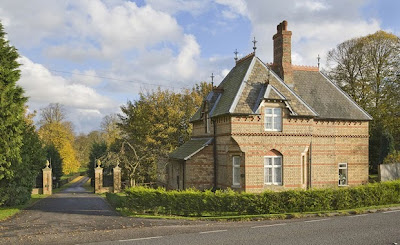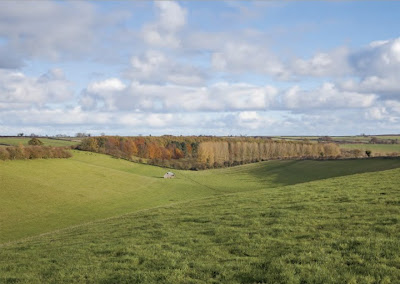In March (2013) there were a handful of unverified reports in local media outlets that well-compensated British actor Daniel Craig—he's set to haul in an astonishing £31,000,000 for the next two installments of the never-ending franchise—had been spotted peeping pastoral properties near the market town of Beverley (Yorkshire), several hours by car north of London. Starting sometime in late July there was a shit-ton of speculation in the U.K. that the suave, 45-year old superstar and his Oscar-winning wife, Rachel Weisz, might be the supposed buyers of Dalby Hall Estate, a baronial, 19th-century country estate near Spilsby (Lincolnshire), about 145 miles north of London's Buckingham Palace that was abruptly taken off the market right around the time of the July rumors began.
The estate agent for Dalby House since clarified the situation; Although the genteel property—more like a small village than what we Americans think of as an estate—was indeed withdrawn from the market it is not—or was not then, anyways—under offer. Mister Craig's people also put the kibosh the quickly ballooning real estate scuttlebutt saying their client hadn't even been in the U.K. at the time of this supposed house hunting.
Whatever the case, we thought it might be a bit of a hoot to have a look at what all the hullabaloo was all about since our occasional (and much appreciated) U.K.-based aide-de-camp Flower Perfectbush recently directed us towards the still-accessible digital marketing materials that show the 1,050-ish acre Dalby Hall spread was last listed with a guide price—that's an asking price in British real estate speak—of £12,000,000.*
The existing house, a grandly proportioned, Grade II listed edifice (and ancillary office and coach house) set privately amid mature park lands, was designed by vaunted Victorian-era ecclesiastical architect James Fowler and built in 1856 after the earlier iteration of Dalby Hall was destroyed by fire in 1841. Later alterations and additions were executed by another church architect, Gothic Revival specialist Temple Moore.
Our boozy study of the floor plan included with above mentioned marketing materials indicates the almost 10,000 square foot mansion has four principal bedrooms on the second floor—each with private bathroom and four additional bedrooms in separate wing on the second and third floors that share two hall bathrooms. We counted a total of six full and four half bathrooms (or water closets), at least a dozen wood-burning fireplaces, and both front and rear staircases.
An elegantly scaled trio of reception rooms orbit around the central reception hall: A roomy library has paneled walls painted a particularly awful shade of salmon and bowed window bay with a direct view of the mansion's gravel fore court: The nearly 1,000 square foot drawing room—otherwise known by us folk across the Pond as a formal living room—has parquet floors and a second bowed window bay of epic proportions; A banquet hall-sized formal dining room has three over-sized sash windows that frame bucolic vistas out over the rolling lawns that stretch out behind the house.
More intimate living spaces on the main floor include a cozy snug—to be honest, Your Mama ain't sure what a snug is—with three curved windows set into another over-sized bowed window bay. The adjoining study connects through to the exceedingly long, L-shaped corridor that links the various areas of the service wing.
Speaking of the service wing, in addition to a small small but renovated kitchen and roomy adjoining breakfast room there's a laundry room bigger than most bedrooms, a walk-in larder, and a walk-in refrigerator. At the opposite end of the L-shaped service wing corridor there's a 20+ foot long boot room—Americanos would probably call it a mud room—with convenient half bathroom. The service wing wraps almost entirely around an interior courtyard off of which open a boiler room, gun room, water closet, and additional storage space.
The courtyard opens to a parking lot-sized motor court bordered by a coach house (above right) with garage space for four cars, a walk-in freezer room, workshop, storage, and a second floor games room. At a right angle to the coach house is the former stable block (above left), now fitted with generator, water filtration, and storage rooms and, on the second floor a pair of offices with a wee kitchenette in between.
Additional residential structures include the Fordington Farmhouse—two stories, 13 rooms, four bedrooms, 2.5 bathrooms—and six additional two- and three-bedroom cottages and a three-bedroom Tudor Gothic gatehouse lodge (above) also designed in the mid-1800s by James Fowler. A seventh cottage sits, according to marketing materials, semi-derelict with a "commanding position on the edge of the parkland."
The estate, a functioning farm with certified organic crop lands, unspoiled woodlands, and vast undulating grasslands grazed by a herd of organic cattle and a flock of Hebredian sheep, has three separate farmyards with more farm-related structures than we care to count. The manicured grounds that surround the house include extensive gardens and orchards, broad sweeps of rolling lawns, a tennis court with nearby summer house with changing rooms. A bit farther afield there's a multi-acre trout-stocked pond, an established shoot, an aviary, a free-range chicken run, and a private airstrip.
Whether they did or did not buy or even have or had the vaguest interest in Dalby Hall Estate, Mister Craig and Miz Weisz, combined, none-the-less possess an impressive property portfolio both in the U.S. and the U.K. Miz Weisz owns an 18th century farmhouse in upstate New York's Marbletown, near the historic village of Stone Ridge, that she previously shared with her ex-husband, Oscar-winning American filmmaker Darren Aronofsky, and recently renovated with her current husband who had a work out space installed on the property.
As far as we know—and we really know so very little—Mister Craig still owns a swank, two-floor apartment in the plummy, celebrity-saturated Primrose Hill area in North London that he scooped upin 2008 for about £3 million. And, as far as we know—and, again, we really know so very little—Mister Craig long ago decamped his Primrose Hill pad for the four floor townhouse, also in Primrose Hill, that Miz Weisz bought in 2008 for £3.25 million and previously shared with her ex-husband.
In late May, 2010, Mister Craig and his then long-time but now former lady-make, Satsuki Mitchell, were said to be in the process of acquiring a sun-soaked duplex townhouse in New York City's TriBeCa 'hood that was last listed for $1.995 million. Deeds and documents we peeped show three terrace penthouse pad is owned solely by Miz Mitchell who paid $1,781.937 for the one bedroom and two bathroom apartment that has been for lease a couple times over the last few years, most recently for five days in early July (2013) at a rate of $10,000 per month.
In early 2012 Miz Weisz's ex-husband bought out her interest in a petite, 13-foot wide townhouse in New York City's East Village they bought in 2005 for $3.4 million. At about the same time, the then newly wedded Craig-Weisz's shelled out a downright proper $10.8 million for a lofty 4,350 square foot triplex penthouse in SoHo that listing details from the time show had, 60-foot long living/dining/kitchen area plus a cozier den with fireplace, 2-4 bedrooms depending on usage, three full bathrooms, one big kitchen and a second kitchenette on the uppermost level, and three interconnected terraces that add about 2,000 additional square feet of living space.
*A few quick clicks and clacks on Your Mama's handy-dandy currency conversion contraption shows that amounts to $18,658,800 (U.S.) and €14,129,400 for the Continentals.
listing photos and floor plan: Brown & Co.
Tuesday, September 3, 2013
Subscribe to:
Post Comments (Atom)











3 comments:
Pretty, but a white elephant. What are they going to do? Host shooting parties?
Wanted to jump in on this write-up before it falls below the fold.
This is most certainly a fiefdom! Who owns or is buying make no difference to me. Just happy to know it exists. Pretty spectacular buildings, siting, bones and provenance.
Following is my two cents from a far-far-far less grand ivory tower, but it's fun to imagine.
I have to look past some of the God awful décor decisions. The mortuary window treatments and surface corrections would be a good start. I can't see why the current owner would bother lugging this hodgepodge of furniture off to their next monumentally elaborate estate.
On that assumption, for my money, I'd get a reputable auction house in there to help decide what to keep, what to let them market, and have a bonfire party with the rest.
While I'm dreaming, I'd also palm a museum curator for a side job to monitor the auction house's recommendations on the what to keep / let them market piece. (I only mention this because a friend's elderly aunt consulted major auction house about scaling down her possessions. She was deceptively -- and regretfully -- compromised, to put it nicely. This is not meant to disparage resellers, but there's a lot of stuff in there.)
It's going to take a boat load of cash and major editing by a fleet of nice gay decorators to bring these interior spaces up to Mama's Real Estalker code.
Thanks for sharing, Mama.
The Rabbi concurs wholeheartedly with Sandpiper. She also pines for yesteryear, when many of Mama's Kinderlach would have commented on this Grade II estate. The Rabbi hopes the drawing and dining room chandeliers are important; the latter is at least proportional to its room and could possibly be comprised of antique Irish crystal.
Rabbi Hedda LaCasa
Post a Comment